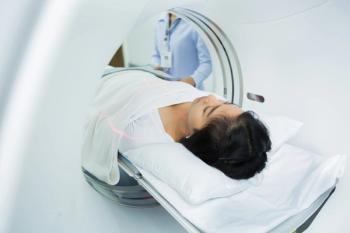
Study Shows Promise of Emerging Radiotherapeutic Agent for Treatment of Gastroenteropancreatic Neuroendocrine Tumors
Use of the radiotherapeutic agent 177Lu-edotreotide (ITM-11) demonstrated significantly higher absorption in gastroenteropancreatic neuroendocrine tumors than normal organs along with a favorable safety profile, according to SPECT research recently presented at the European Association of Nuclear Medicine (EANM) conference.
For patients with grade 1 or grade 2 gastroenteropancreatic neuroendocrine tumors (GEP-NETs), new research suggests the radiotherapeutic agent 177Lu-edotreotide (ITM-11) may enhance targeted treatment with a reduced rate of adverse side effects in comparison to everolimus.
In single-photon emission computed tomography (SPECT) findings from a phase 3 trial, recently presented at the European Association of Nuclear Medicine (EANM) conference, researchers showed a mean cumulative absorbed dose of 110 Gy after one cycle of treatment with 177Lu-edotreotide in patients with grade 1 or grade 2 somatostatin receptor (SSTR)-positive GEP-NETs. The mean cumulative absorbed dose for 177Lu-edotreotide (ITM-11) was 0.8 Gy for the whole body, according to the research.
In a recent interview with Diagnostic Imaging, study co-author Emmanuel Deshayes, M.D., Ph.D., offered his insights on the dosimetry data for 177Lu-edotreotide.
“(177Lu-edotreotide) was able to achieve a specifically high affinity for somatostatin receptors (SSTR) that are highly expressed and well differentiated in gastroenteropancreatic neuroendocrine tumors,” pointed out Dr. Deshayes, an associate professor of nuclear medicine at the Montpellier Cancer Institute in Montpellier, France.
The researchers also noted that the mean cumulative absorbed dose with 177Lu-edotreotide in the kidneys and red bone marrow was within established safety thresholds. Additionally, in comparison to everolimus, the study authors noted a 6.5 percent reduction in renal and urinary grade 1 > adverse events with 177Lu-edotreotide.
“The safety profile of the drug tested, 177Lu-edotreotide, was very favorable compared to everolimus. … For example, the renal adverse events occur less often (with) 177Lu-edotreotide compared to the everolimus group,” added Dr. Deshayes.
(Editor’s note: For related content, see “
For more insights from Dr. Deshayes, watch the video below.
Newsletter
Stay at the forefront of radiology with the Diagnostic Imaging newsletter, delivering the latest news, clinical insights, and imaging advancements for today’s radiologists.




























